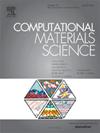Inductive determination of reaction–diffusion model parameters via dislocation pattern recognition using a convolutional neural network
IF 3.3
3区 材料科学
Q2 MATERIALS SCIENCE, MULTIDISCIPLINARY
引用次数: 0
Abstract
Dislocation patterning under cyclic loading is a hallmark of microstructural evolution in crystalline materials. The Walgraef–Aifantis (WA) model captures these phenomena through a set of nonlinear reaction–diffusion equations, yet the inductive determination of its parameters from observed patterns remains a significant challenge. This study presents a data-driven framework that leverages convolutional neural networks (CNN) to predict key WA model parameters, accounting for anisotropic diffusion, directly from simulated dislocation structures. A dataset of over 13,824 patterns was generated via numerical simulations under varied WA parameters. The CNN model demonstrates high accuracy in multi-parameter regression, enabling top-down inference of loading conditions from microstructural features. This work advances the integration of machine learning with physical modeling for microstructural characterization and fatigue diagnostics.

基于卷积神经网络的位错模式识别反应扩散模型参数的归纳确定
循环载荷下的位错模式是晶体材料微观结构演变的标志。Walgraef-Aifantis (WA)模型通过一组非线性反应扩散方程捕捉到这些现象,但从观察到的模式中归纳确定其参数仍然是一个重大挑战。本研究提出了一个数据驱动的框架,利用卷积神经网络(CNN)直接从模拟的位错结构中预测关键的WA模型参数,考虑各向异性扩散。通过不同WA参数下的数值模拟,生成了超过13824个模式的数据集。CNN模型在多参数回归中具有较高的精度,可以从微观结构特征中自上而下地推断加载条件。这项工作推进了机器学习与微观结构表征和疲劳诊断的物理建模的集成。
本文章由计算机程序翻译,如有差异,请以英文原文为准。
求助全文
约1分钟内获得全文
求助全文
来源期刊

Computational Materials Science
工程技术-材料科学:综合
CiteScore
6.50
自引率
6.10%
发文量
665
审稿时长
26 days
期刊介绍:
The goal of Computational Materials Science is to report on results that provide new or unique insights into, or significantly expand our understanding of, the properties of materials or phenomena associated with their design, synthesis, processing, characterization, and utilization. To be relevant to the journal, the results should be applied or applicable to specific material systems that are discussed within the submission.
 求助内容:
求助内容: 应助结果提醒方式:
应助结果提醒方式:


